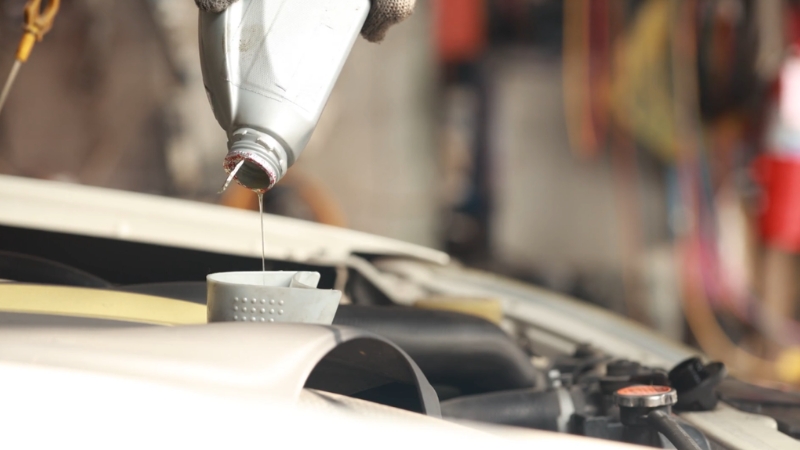
Share Post:
Seeing white smoke puffing out of your car’s exhaust can be unsettling. It often hints at something deeper going on under the hood.
Knowing what’s causing the issue and how to address it is key to keeping your car running smoothly. Let’s explore the common culprits and what you can do about them.
Table of Contents
ToggleCauses of White Smoke
1. Morning Condensation
Ever noticed a thin trail of white smoke on chilly mornings? That’s usually just condensation burning off. Overnight, moisture can collect in your exhaust system.
When you start your car, the heat turns that moisture into harmless steam. If the smoke disappears after a few minutes, there’s no need to worry.
2. Coolant in the Combustion Chamber (A Serious Concern)
When white smoke lingers and carries a sweet smell, it might mean coolant is leaking into the combustion chamber. This happens due to issues like:
Blown Head Gasket
The head gasket seals critical engine components. When it fails, coolant can seep into areas it shouldn’t, producing thick white smoke. You might also notice:
- Overheating
- Low coolant levels without external leaks
Cracked Cylinder Head or Engine Block
Cracks in these parts can let coolant into the combustion chamber. Aside from the smoke, this issue may cause:
- Engine misfires
- Significant overheating
Both situations require prompt attention to prevent further damage.
3. Faulty Fuel Injectors

Fuel injectors ensure the engine gets the right mix of fuel and air. When they malfunction, combustion becomes uneven.
This incomplete combustion can lead to white smoke and a noticeable dip in engine performance. Cleaning or replacing the injectors usually resolves the problem.
4. Transmission Fluid Leaks
In vehicles with a vacuum modulator, a faulty one can pull transmission fluid into the engine. When burned, the fluid creates white smoke with a distinct burnt odor.
Although this issue isn’t as common, it’s essential to address it quickly to avoid further complications.
5. Oil Leaks

While oil burning typically produces bluish smoke, it can sometimes appear white under certain conditions. This can happen if:
- Piston rings are worn
- Valve seals are deteriorating
Other signs include increased oil consumption and a drop in engine performance. Ignoring this issue could lead to costly repairs down the line. Also, you should check power steering fluids as well.
Diagnosing the Problem
To figure out the root cause, start with a few simple checks:
Coolant Levels

Low coolant without visible external leaks? That could indicate internal leakage, possibly from a blown head gasket or cracked engine parts, or it is time to change coolant.
Exhaust Smoke Characteristics
Pay attention to the smoke:
- Thin and short-lived? Likely condensation.
- Thick, persistent, and sweet-smelling? Coolant might be burning.
Engine Oil Appearance
Check the dipstick. Milky or frothy oil signals coolant contamination, which often points to a gasket or cylinder issue.
Compression Test
This test measures the pressure in each cylinder. Low pressure in one or more cylinders often points to internal damage, like a failing gasket or worn piston rings.
Solutions for Each Cause

Once you’ve pinpointed the source of the white smoke, it’s time to tackle the issue with the right approach. Here’s a detailed breakdown of what each solution involves and what to expect:
Blown Head Gasket
A blown head gasket is a serious issue that demands immediate attention. This component seals the engine block and cylinder head, preventing coolant and oil from mixing or leaking into the combustion chamber.
When it fails, replacing the gasket is the only way to restore proper engine function.
- What’s Involved: The repair involves dismantling significant parts of the engine, cleaning the surfaces, and installing a new gasket.
- Estimated Cost: Depending on your car make and model, repairs usually range from $1,000 to $2,000.
Cracked Cylinder Head or Engine Block
Cracks in the cylinder head or engine block allow coolant to seep into areas where it doesn’t belong. The solution depends on the extent of the damage:
- Minor Cracks: These might be repairable with specialized welding or sealants, but the fix must be durable enough to handle high pressures and temperatures.
- Severe Cracks: If the damage is extensive, replacing the cylinder head or block may be your only option.
- Estimated Cost: Repairs can range from $500 for minor fixes to over $3,000 for replacements.
- Key Consideration: Repairing a cracked engine block is often less cost-effective than replacement, especially in older vehicles.
Faulty Fuel Injectors
Fuel injectors are crucial for delivering the right mix of fuel and air into the engine. When they fail, they disrupt combustion, leading to smoke and reduced performance.
- What’s Involved: Cleaning injectors might solve the problem if dirt or debris is causing the malfunction. If the injectors are beyond repair, they’ll need replacement.
- Estimated Cost: New injectors typically cost between $200 and $800 per unit, depending on your vehicle.
- Benefits of Repair: Once repaired or replaced, you’ll notice smoother engine performance and improved fuel efficiency.
Transmission Fluid Leaks
If transmission fluid is making its way into the engine and burning, you likely have a faulty vacuum modulator.
- What’s Involved: A mechanic will inspect the vacuum system, identify the malfunctioning part, and either repair or replace it. Addressing the root cause of the leak is vital to prevent further damage.
- Estimated Cost: Costs depend on the severity of the leak and the specific part needing replacement, but repairs are often affordable compared to ignoring the problem.
Oil Leaks
When oil enters the combustion chamber, it typically signals worn piston rings or valve seals. These components must be replaced to stop the leak and restore engine health.
- What’s Involved: Replacing piston rings or valve seals requires disassembling parts of the engine, cleaning the components, and reassembling them with new seals or rings.
- Estimated Cost: The cost varies widely, ranging from $1,000 to $5,000, depending on the severity of the issue and the vehicle type.
- Warning Signs: Delaying repair can lead to further engine damage, including cylinder wear or even engine failure.
Preventative Measures

Regular maintenance goes a long way in avoiding the headache of white smoke:
Check Fluid Levels
Make it a habit to inspect coolant and oil levels regularly. Spotting changes early can save you money.
Address Issues Quickly
If you notice signs like overheating, unusual smoke, or odd smells, don’t ignore them. Early intervention often prevents larger problems.
Visit a Professional Mechanic
Scheduling regular inspections ensures that hidden issues are caught before they turn into costly repairs. A mechanic can spot wear and tear you might miss.
Wrapping Up
White smoke from your exhaust isn’t always a bad sign, but persistent or thick smoke deserves attention. From condensation burn-off to more serious issues like coolant leaks or oil entering the combustion chamber, the underlying causes vary.
Acting quickly when you notice something unusual can save you money and keep your car running smoothly. Car troubles can be stressful, but addressing them head-on ensures a safer and longer-lasting vehicle.
Keep an eye out, stay proactive, and don’t hesitate to get professional help when needed. Safe driving!
Related Posts:
- Coolant Leak from the Bottom of the Car - Causes and…
- Why Does My Car Smell Like Gas? Common Causes and Solutions
- Why Does My Car Squeak When Turning? Common Causes…
- What Causes the Rotten Egg Smell in Your Car?
- Subaru CarPlay Not Working: 5 Common Reasons & Solutions
- Car Clicking But Won’t Start? Common Causes and How…








